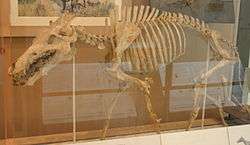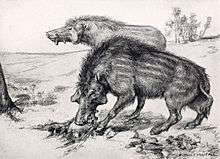Archaeotherium
| Archaeotherium Temporal range: Late Eocene to Early Oligocene | |
|---|---|
 | |
| Archaeotherium mortoni skeleton | |
| Scientific classification | |
| Kingdom: | Animalia |
| Phylum: | Chordata |
| Class: | Mammalia |
| Order: | Artiodactyla |
| Family: | †Entelodontidae |
| Genus: | †Archaeotherium Leidy (1850) |
Archaeotherium (Greek: αρχαιοθήριον, meaning "ancient beast") is an extinct genus of entelodont artiodactyl endemic to North America during the Eocene and Oligocene epochs (38—24.8 mya), existing for approximately 6 million years.[1] Archaeotherium was about 1.2m tall at the shoulder and around 2m long and weighing around 270 kg.
Although superficially pig-like, Archaeotherium, along with all other entelodonts, was more closely related to anthracotheres, hippopotamuses, and whales. Evidence from the Wyoming Dinosaur Center suggests that the omnivorous Archaeotherium, like many modern predatory mammals, kept caches of food for times when their hunting was less successful.
Taxonomy


Archaeotherium was named by Leidy (1850). Its type is Archaeotherium mortoni. It was synonymized subjectively with Entelodon by Joseph Leidy (1853) and synonymized subjectively with Elotherium by Leidy (1857). It was assigned to Entelodontidae by Leidy (1850), Peterson (1909), Scott (1940), Galbreath (1953), Russell (1980), Carroll (1988) and Effinger (1998).[2][3]
Morphology
In life, Archaeotherium probably resembled a large, fanged, cow-sized peccary with bumps projecting from the side of its head. It had high shoulders, presumably to carry strong neck muscles to support the heavy head. The brain was tiny, but had relatively large olfactory lobes, suggesting that the animal had a keen sense of smell.[4]
The largest (and type) species, A. mortoni was a cow-sized predator. Rhino jaws and other mammal bones have been found with bite marks on them that match the large canines of A. mortoni. A fossil trackway in Toadstool Geologic Park depicts the path of a Subhyracodon walking forward, stopping to see an Archaeotherium approach, then breaking into a gallop with the entelodont chasing after it. In leaner times, it is suggested that Archaeotherium dug for roots and tubers, as with other pig-like mammals.[4]
References
- ↑ PaleoBiology Database: Archaeotherium, basic info
- ↑ O. A. Peterson. 1909. Memoirs of the Carnegie Museum
- ↑ W. B. Scott. 1940. The mammalian fauna of the White River Oligocene; Part 4, Artiodactyla; Part 5, Perissodactyla. Transactions of the American Philosophical Society 28(4):363
- 1 2 Palmer, D., ed. (1999). The Marshall Illustrated Encyclopedia of Dinosaurs and Prehistoric Animals. London: Marshall Editions. p. 267. ISBN 1-84028-152-9.